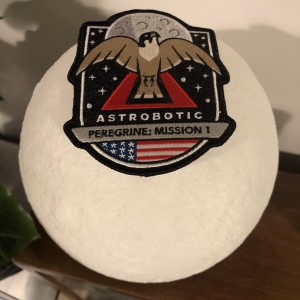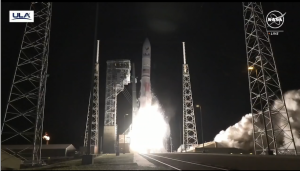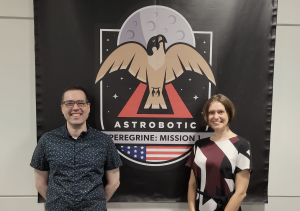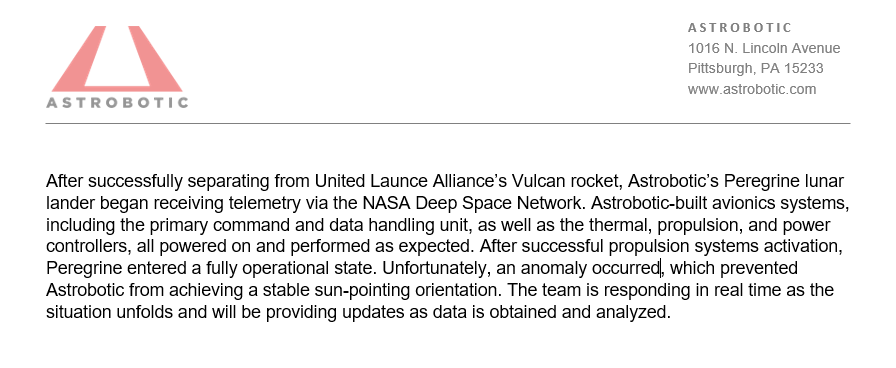Jan
21
Astrobotic: Peregrine Mission 1
Astrobotic is an American commercial space company with its headquarters in Pittsburgh. It was originally formed to compete in the Google Lunar X-Prize (GLXP) – an international competition to send a commercial lander to the Moon, land, deploy a rover that could drive 500m and send high-quality video back from the Moon. The competition officially ended in 2018 with no team successfully winning the prize money, but Israel’s SpaceIL and Japan’s Team Hakuto went on to attempt lunar landings, sadly without success. Although no-one won the GLXP, it boosted the commercial industry and led to NASA’s Commercial Lunar Payload Services (CLPS) programme. Astrobotic is the first company to launch under the CLPS programme and hoped to deliver NASA scientific payloads to the Moon.

Peregrine Mission 1 patch
What was Peregrine Mission 1?
PM-1 was the first attempt by an American private space company to land a spacecraft on the Moon. At the time the mission launched, only four countries – the US, Soviet Union (as was), China and India had successfully managed a soft landing on the Moon.
The mission was carrying payloads from 16 customers from seven nations, and included five CLPS payloads, and an additional experiment from NASA. The mission launched on 8th January, 2024, and was due to land on the Moon on 23rd February.

Vulcan launches Peregrine Mission 1
What happened?
After a smooth launch on ULA’s Vulcan rocket, the Astrobotic team conducted spacecraft checkout procedures, and then discovered an anomaly. The rest of the day was a total rollercoaster for anyone following the mission.
An issue with a valve on one of the fuel tanks led to the tank being breached and they were losing fuel. In addition, the spacecraft was not pointing in the right direction for the solar panels to be charged by the Sun. The team attempted to reorient the spacecraft and managed to recharge the internal batteries and extend the life of the spacecraft.
Over the next few days, the team managed to eke out additional mission time, and activate the payloads with an electrical connection to the lander so that they could be tested, and data collected. As the propellant leaked out, pressure in the tank reduced and the leak slowed, allowing them to further extend the life of the lander.
The spacecraft reached lunar distance, but at a point in time when the Moon was not at that position. The mission trajectory had them returning to Earth before rendezvousing with the Moon two weeks later. As the spacecraft returned to Earth, there was a chance that they might have had enough propellant to conduct a swing-by and return to lunar distance to attempt a lunar collision, but after much discussion, the company decided the responsible thing would be to allow the craft to burn-up in Earth’s atmosphere, rather than risk creating space debris in cis-lunar space.
This must have been a really tough decision for a team that had been working for 16 years to make this mission a reality, but Astrobotic proved themselves to be a class act with their regular, clear and transparent mission updates, and this difficult, but admirable decision.

Kate and Nate in Peregrine Mission Control, 2022
So the mission failed, that’s bad isn’t it?
While the mission didn’t successfully land on the lunar surface, to write it off as a complete failure would be unfair. To get a spacecraft into space, manage to operate it despite a fuel leak, operate payloads and receive data is all still very impressive, especially for a first try by a commercial company. They will have learned a lot from this mission and that will feed into the company’s next mission attempt, due later this year.
Landing on the Moon is hard, and over the past few years there have been numerous failures. In 2019 Israel’s Beresheet mission failed to soft-land, as did India’s Chandraayan-2. In 2022 Japanese company i-space’s Hakuto-R Mission 1 failed, and in 2023 Russia’s Luna 25 “ceased to exist after a collision with the lunar surface”, as reported in their press release. China’s lunar programme has multiple successes, including the first landing on the far side of the Moon with Chang’e 4 in 2018, and a sample return mission Chang’e 5 in 2020. India joined the ‘lunar landing club’ in 2023, with Chandraayan-3 successfully landing on the Moon. On 19th/20th January 2024 (depending on your time zone) Japan’s SLIM spacecraft soft landed on the Moon, making them the fifth nation ever to do so.
What does this mean for NASA?
Although there were several NASA payloads on this mission, it’s important to remember that this wasn’t a NASA mission, rather NASA was a passenger on Astrobotic’s mission. It’s not just a matter of semantics, and here’s why.
The CLPS programme, whereby NASA pays commercial companies to deliver their payloads to the Moon, is designed to both boost the commercial space industry and encourage multiple competing companies to develop technology, and also to help reduce costs for NASA. If NASA were to design, develop, build and operate a mission, it would be more costly, and they would be taking on the entire risk of the project. By paying for commercial companies to provide these services (much like they do for cargo delivery and crew transport to the ISS) they can focus their resources on other areas of science and exploration. With the reduced costs, they are also able to accept a higher level of risk, and at the time the first CLPS contracts were given out, Dr Thomas Zurbuchen, who was NASA’s Associate Administrator for the Science Mission Directorate at the time, said they were prepared for around 50% of the initial missions not to work. This is *very* different to the level of risk they would tolerate on a normal mission, and allows NASA to take advantage of different companies testing and refining their technology.
But NASA has delayed it’s crewed Artemis flights, hasn’t it?
Yes. NASA announced on January 9th, the day after Peregrine launched and the anomaly was discovered, that it was delaying its crewed mission around the Moon (Artemis II), from no earlier than (NET) November 2023, to September 2024, and the lunar landing flight, Artemis III, until NET September 2026.
I was asked in a radio interview if this was due to the Astrobotic failure, but I believe this was just unfortunate timing for Astrobotic! The success or failure of their mission shouldn’t have had any impact on the Artemis schedule.
The decision to delay was made for a variety of reasons, including the need for further research on the thermal protection system, an issue with a circuit on Orion that needs correcting, and progress of external partners.
When they announced the delays, NASA was very keen to stress that crew safety was always their number one priority. They will fly when they are ready.
What was onboard Peregrine?
Peregrine was carrying a range of scientific and non-scientific payloads for customers from seven countries.
The CLPS payloads for NASA were:
- a laser retro reflector array acting as a location marker attached to the lander
- a neutron spectrometer to study regolith at the landing site and measure the presence of hydrogen
- a linear energy transfer spectrometer, to learn about the radiation environment, like the one sent on Exploration Mission I (EM-1) to gain information about the radiation that astronauts might be subjected to during Artemis missions
- a near infra-red mass spectrometer – to measure surface and sub-surface hydrations, look for water, hydroxyl, carbon dioxide and methane molecules, as well as mapping the surface temperature and morphology
- an ion trap mass spectrometer – designed to characterise the Moon’s exosphere after descent and landing. Taking observations of the outermost bit of atmosphere would enable an understanding of what volatiles were kicked up during landing. (NASA, ESA and the Open University partnered on this instrument)
An additional NASA payload was the navigation doppler Lidar, to precise velocity tracking and range sensing.
Carnegie-Mellon University sent up a student-built ‘nano’ lunar rover, with a mass of approximately 1.8 kg (4lbs). It was designed to work for around 50 hours on the lunar surface.
Astrobotic wanted to test their terrain relative navigation sensor, to allow more accurate landings on the Moon – and other locations in future.
An additional scientific payload came from Mexico, with their COLMENA project, which looked to test incredibly small robots (12 cm, <60 g) to see if the five robots could self-organise on the lunar surface. They are designing these with a view to future exploration and mining.
German Space Agency DLR sent up the M-42 radiation detector, again hoping to learn more about radiation and feed into the Artemis programme.
Non-scientific payloads
From Japan, Astroscale’s Pocari Sweat lunar dream capsule sent the messages from tens of thousands of children around the world into space. This payload was clearly visible in some of the images that Astrobotic managed to capture during their mission.
From The Seychelles, a unique physical Bitcoin, loaded with one bitcoin was sent.
On the Bitcoin theme, US Bitcoin Magazine sent a copy of the ‘genesis block’ – the first block of bitcoin to be mined. UK company SpaceBit sent a SpaceBit plaque (though originally they had talked about sending a small rover).
Also from the US customers were the MoonArk payload “a set of intricately designed objects to spark wonderment” and represent arts, humanities and sciences, The Arch Library, a long-term archive being sent to different planets and the Moon, and two space memorial flight services payloads. Some of the Celestis payload was sent into a Sun synchronous orbit by the Vulcan rocket, and both Elysium and Celestis offer to inter remains on the lunar surface. This sparked some controversy with the Navajo Nation calling for discussion about whether human remains should be allowed to be sent to the Moon, which they regard as sacred.
The Hungarian payload ‘Memory of Mankind* on the Moon’ was a plaque with archive text and images that could be magnified and read.
Last but not least – the DHL MoonBox – from Germany, allowed people to buy capsules and send mementoes and keepsakes to the Moon. Certainly more exciting than your usual parcel tracking, but sadly the items were ultimately ‘lost in the post’ – or more technically, burned up in Earth’s atmosphere. Still, they gave members of the public the opportunity to put something of theirs in space, and that’s a whole new level of access.
*I prefer and promote usage of more inclusive terms such as humanity, but this was the actual listed name of the payload
So, what’s next?
Just a day after Astrobotic’s mission came to a fire-y end, Japan’s SLIM mission successfully landed on the Moon, making them the fifth nation to do so.
Another US company with a CLPS contract, Intuitive Machines, is set to launch its first mission to the Moon in early 2024. They hope to land at Malapert A near the South Pole and will be carrying five NASA CLPS payloads as well as commercial cargo. They hoped to launch between 12th-16th January, but scheduling delays pushed the launch to NET February. Had Astrobotic not had its fuel leak, there was a chance that both PM-1 and IM-1 would have attempted their lunar landings within a matter of days, as Intuitive Machines have opted for a faster route from Earth to the Moon.
The next Astrobotic launch is due in November 2024, and will see its Griffin lander attempt to land at on the lunar surface, delivering NASA’s Volatiles Investigating Polar Exploration Rover (VIPER) to the south pole of the Moon to search for water ice and other resources.


